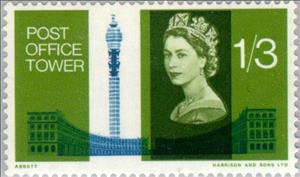Stamp: Tower and 'Nash' Terrace, Regent's Park (phosphor) (United Kingdom of Great Britain & Northern Ireland 1965)
Tower and 'Nash' Terrace, Regent's Park (phosphor) (United Kingdom of Great Britain & Northern Ireland 1965)
08 October (United Kingdom of Great Britain & Northern Ireland ) within release Post Office Tower goes into circulation Stamp Tower and 'Nash' Terrace, Regent's Park (phosphor) face value 1'3 British shilling
| Stamp Tower and 'Nash' Terrace, Regent's Park (phosphor) in catalogues | |
|---|---|
| Michel: | Mi:GB 403y |
| Yvert et Tellier: | Yt:GB 416A |
| Stanley Gibbons: | Sg:GB 680p |
| AFA number: | AFA:GB 397D |
Stamp is horizontal format.
Three phosphor bandsAlso in the issue Post Office Tower:
- Stamp - Tower and Georgian Building face value 3;
- Stamp - Tower and Georgian Building (phosphor) face value 3;
- Stamp - Tower and 'Nash' Terrace, Regent's Park face value 1'3;
- Stamp - Tower and 'Nash' Terrace, Regent's Park (phosphor) face value 1'3;
- Stamp - Tower and Georgian Building (phosphor) face value 3;
- Se-tenant - Tower and Georgian Building (phosphor) face value 2*3;
Stamp Tower and 'Nash' Terrace, Regent's Park (phosphor) it reflects the thematic directions:
Special Occasions
The mail or post is a system for physically transporting documents and other small packages; or, the postcards, letters, and parcels themselves. A postal service can be private or public, though many governments place restrictions on private systems. Since the mid-19th century national postal systems have generally been established as government monopolies with a fee on the article prepaid. Proof of payment is often in the form of adhesive postage stamps, but postage meters are also used for bulk mailing. Modern private postal systems are typically distinguished from national postal agencies by the names "courier" or "delivery service". Postal authorities often have functions other than transporting letters. In some countries, a postal, telegraph and telephone (PTT) service oversees the postal system, in addition to telephone and telegraph systems. Some countries' postal systems allow for savings accounts and handle applications for passports.
Communication is commonly defined as the transmission of information. Its precise definition is disputed and there are disagreements about whether unintentional or failed transmissions are included and whether communication not only transmits meaning but also creates it. Models of communication are simplified overviews of its main components and their interactions. Many models include the idea that a source uses a coding system to express information in the form of a message. The message is sent through a channel to a receiver who has to decode it to understand it. The main field of inquiry investigating communication is called communication studies.
A tower is a tall structure, taller than it is wide, often by a significant factor. Towers are distinguished from masts by their lack of guy-wires and are therefore, along with tall buildings, self-supporting structures.




